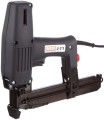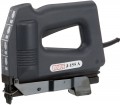Compatible staples
Staple models that the tool is compatible with.
Usually, quite specific options are indicated in this paragraph, so finding compatible consumables is not difficult. The specific dimensions of the fasteners should be specified according to the manufacturer's data — different brands use different markings.
Min. staple width
The smallest staple width that the stapler can handle.
The width of the bracket is, roughly speaking, the distance between its legs. Different situations and types of work require different sizes of staples, sometimes quite small. At the same time, staples that are too small will hang out in the store and will not be able to properly fit under the drummer, which is why modern staplers have a minimum size limit. You should pay special attention to it if you plan to work with brackets of small width.
Max. staple width
The largest width of staples (see Fastener Type) that the stapler can work with.
The width of the bracket is, roughly speaking, the distance between its legs. Different situations and types of work require different sizes of staples, and sometimes the width must be quite large. However, a staple that is too large simply will not fit into the store, not to mention the fact that the stapler can “shoot” it normally. Therefore, this limit cannot be exceeded, and if you plan to work with brackets, you should pay special attention to the maximum width when choosing.
Min. staple length
The smallest length of staples (see Fastener Type) that the stapler can work with.
The length in this case means the length of the leg — in other words, the depth to which the staple clogged "to the stop" penetrates into the material. Small staples do not require much power to drive, but the tool may not be designed for fasteners that are too short due to other parameters — for example, the design of the magazine. Therefore, for many models, this limitation is quite relevant, and in powerful professional models, the minimum length can be quite large — more than 20 mm.
Max. staple length
The largest length of staples (see Fastener Type) that the stapler can work with.
The length in this case means the length of the leg — in other words, the depth to which the staple clogged "to the stop" penetrates into the material. This means that working with staples of great length requires not only the appropriate design of the magazine and the feed mechanism — the stapler must also be quite powerful in order to provide the effort necessary for effective clogging. And this, in turn, affects the dimensions, weight and price of the tool. In fact, this means that it does not always make sense to specifically look for a model that can work with long staples — you need to evaluate the specifics of the intended work: often the best choice is a relatively “short”, but at the same time inexpensive and compact tool.
In general, a limit of 10 – 15 mm is typical for entry-level staplers, and in professional models this parameter can exceed 50 mm.
Min. nail length
The shortest length of nails (see Fastener Type) that the stapler can handle.
The shorter the fastener, with the same thickness, the less effort is required to drive it, but a nail that is too short simply cannot stand under impact normally. Therefore, for many instruments, this restriction is directly indicated. It is worth paying attention to it first of all if you plan to work with small short nails.
Max. nail length
The longest length of nails (see Fastener Type) that the stapler can handle.
With the same thickness, a longer nail requires not only the appropriate space in the magazine and feed mechanism, but also a higher impact energy — otherwise it simply will not work to hammer it “on the head”. This means that the maximum fastener length is directly related to the power and, accordingly, the overall level of the tool. Recall that a powerful professional tool has the appropriate dimensions and weight, moreover, it is often made pneumatic (for more details, see "Type"). Therefore, it makes sense to look for models that are compatible with long nails only if this is critical for the planned work.
Case (bag)
The presence of a case or bag in the tool kit.
Such accessories are more convenient than impromptu packaging, they greatly simplify the storage and transportation of both the tool itself and accessories / consumables. At the same time, cases are the most popular in construction staplers — characteristic suitcases made of solid material. Such a suitcase perfectly protects the instrument not only from moisture and dirt, but also from shocks and shocks; it is also often used as the factory packaging in which the tool goes on sale. Bags made of soft material, in turn, are less common: they do not provide such protection against impacts, and they do not resist water / dust as effectively. On the other hand, such packaging itself is less bulky, and when the bag is not needed, it can be rolled up quite compactly.

